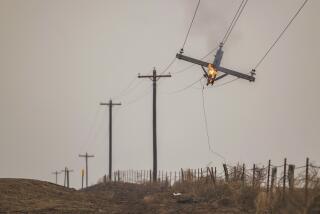Hurricane season 2012: Prediction calls for ‘near normal’
- Share via
The good news on the weather front is that Americans can expect a return to near-normal hurricane conditions this season. The bad news is that normal seems good only because recent years have been so tough.
In predictions released Thursday, forecasters for the National Oceanic and Atmospheric Administration said they expected a near-normal hurricane season for the Atlantic Basin and for the Eastern Pacific region. In both areas, the predicted number of storms falls within the typical range, fewer than in recent years.
“NOAA’s outlook predicts a less-active season compared to recent years,” administration chief Jane Lubchenco said in a prepared statement. “But regardless of the outlook, it’s vital for anyone living or vacationing in hurricane-prone locations to be prepared.”
The Atlantic season begins June 1, and forecasters said there is a 70% chance of nine to 15 named storms with top winds of at least 39 mph. Of that group, four to eight will strengthen into a hurricane with top winds of at least 74 mph; one to three are expected to evolve into a major hurricane of Category 3 or worse. Category 3 hurricanes have winds of at least 111 mph.
Based on records from 1981 to 2010, an average season produces 12 named storms with six hurricanes, including three major hurricanes, the administration said.
The Atlantic season got off to an early start when Tropical Storm Alberto formed last weekend off South Carolina’s coast. The season runs until the end of November with the peak period generally in August and early September. Atlantic storms cross the open ocean and sometimes move into the Gulf of Mexico or track up the eastern coast of the United States.
The most active hurricane season in the Atlantic was in 2005 when Katrina and Rita pushed through the Gulf of Mexico and Texas regions, leaving a trail of death and destruction. But 2010 and last year were tough as well. Both seasons are tied for third in the most-active sweepstakes.
The odds are good for a near-normal Pacific season as well. The hurricane period in the west runs from May 15 to the end of November, with peak activity from July to September. According to the projection from NOAA’s Climate Prediction Center, there is a 50% probability of a near-normal season, a 30% probability of a below-normal season and a 20% probability of an above-normal season.
The prediction calls for between 12 to 18 named storms, which includes five to nine hurricanes. Between two and five are expected to become major hurricanes, Category 3 or higher. An average Eastern Pacific hurricane season produces 15 named storms, with eight becoming hurricanes and four becoming major hurricanes, officials said.
Eastern Pacific tropical storms most often track westward over open waters, sometimes reaching Hawaii and farther. However, some occasionally head toward the Northeast and may bring rainfall to the arid southwestern United States during the summer months. Also, during any given season, two to three tropical storms can affect western Mexico or Central America, officials said.
“The eastern Pacific has gotten off to a busy and early start of the season, with Tropical Storm Aletta last week and Hurricane Bud churning off the Mexican coast this week,” said Gerry Bell, lead forecaster at the center. “NOAA’s seasonal hurricane outlook gives people an idea of how the season will likely unfold so they will be prepared and equipped to respond when disaster strikes. Despite our predictions, it only takes one hurricane to cause a lot of damage and loss of life if people aren’t prepared.”
The forecasts only predict how many storms will form, not whether they will hit land.
One complicating factor is the development of El Niño “if it develops by late summer to early fall,” Bell stated. “In that case, conditions could be less conducive for hurricane formation and intensification during the peak months [August-October] of the season, possibly shifting the activity toward the lower end of the predicted range.”
The release of the predictions coincides with National Hurricane Preparedness Week which begins Sunday.
“Every hurricane season we ask families, communities, and businesses to ensure they are prepared and visit www.ready.gov/hurricanes,” said Tim Manning, Federal Emergency Management Agency administrator for protection and national preparedness. “Being prepared includes developing a family emergency plan, putting an emergency kit together or updating your existing kit, keeping important papers and valuables in a safe place, and getting involved to ensure your community is ready.”
ALSO:
Gallup poll on abortion: ‘Pro-choice’ position hits record low
Alaska barista slaying: In courtroom, suspect makes a run for it
‘Unabomber’ Ted Kaczynski: Proud Harvard alumnus -- or taunter?
More to Read
Sign up for Essential California
The most important California stories and recommendations in your inbox every morning.
You may occasionally receive promotional content from the Los Angeles Times.










